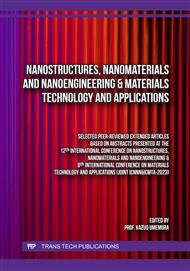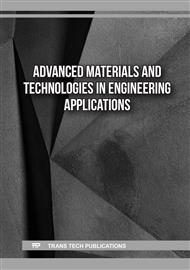[1]
Krishnam, M., Bose, S., & Das, C. (2016). Boron nitride (BN) nanofluids as a cooling agent in the thermal management system (TMS). Applied Thermal Engineering. 951-958 (106). Retrieved from.
DOI: 10.1016/j.applthermaleng.2016.06.099
Google Scholar
[2]
Yuan, P., Tan, D., & Annabi-Bergaya, F. (2015). Properties and Applications of Halloysite Nanotubes: Recent Research Advances and Future Prospects. Applied Clay Science. 112-113, 75-93. Retrieved from:.
DOI: 10.1016/j.clay.2015.05.001
Google Scholar
[3]
Lisuzzo, L., Cavallaro, G. Parisi, F. (2018). Colloidal Stability of Halloysite Clay Nanotubes. Ceramics International. Retrieved from https:// doi.org/.
DOI: 10.1016/j.ceramint.2018.07.289
Google Scholar
[4]
Badea, E., Carsote, C., Hadimbu, E. (2019). The Effect of Halloysite Nanotubes Dispersions on Vegetable-Tanned Leather Thermal Stability. Heritage Science, 7, 68. Retrieved from:.
DOI: 10.1186/s40494-019-0310-x
Google Scholar
[5]
White, D. R., Bavykin, V. D., & Walsh, C. F. (2012). The Stability of Halloysite Nanotubes in Acidic and Alkaline Aqueous Suspensions. Nanotechnology, 23. Retrieved from:.
DOI: 10.1088/0957-4484/23/6/065705
Google Scholar
[6]
Zhou, Z., Fang, L., Cao, Y. (2020). Determination of Hansen Solubility Parameters of Halloysite Nanotubes and Prediction of its Compatibility with Polyethylene Oxide. Colloids and Surfaces A: Physicochemical and Engineering Aspects. Retrieved from:
DOI: 10.1016/j.colsurfa.2020.125031
Google Scholar
[7]
Badea, E., Carşote, C., Hadîmbu, E. (2020). The effect of halloysite nanotube dispersions on vegetable-tanned leather thermal stability. Heritage Science, 68 (7), 68. Retrieved from.
DOI: 10.1186/s40494-019-0310-x
Google Scholar
[8]
Sadeh, P., Najafipour, I., Gholami, M. (2019). Adsorption Kinetics of Halloysite Nanotube and Modified Halloysite at the Palm Oil-Water Interface and Pickering Emulsion Stabilized by Halloysite Nanotube and Modified Halloysite Nanotube. Colloids and Surfaces A: Physicochemical and Engineering Aspects, 231-239. Retrieved from:.
DOI: 10.1016/j.colsurfa.2019.05.034
Google Scholar
[9]
Saif. M. J., Asif H. M., & Naveed M. (2018). Properties and Modification Methods of Halloysite Nanotubes: A State-of-the-Art Review. Journal of the Chilean Chemical Society, 63. 4109-4125.
DOI: 10.4067/s0717-97072018000304109
Google Scholar
[10]
Okonkwo, E., Wole-Osho, I., Almanassra, I., Abdullatif, Y., & Al-Ansari, T. (2020). An updated review of nanofluids in various heat transfer devices. Journal of Thermal Analysis and Calorimetry. Retrieved from.
DOI: 10.1007/s10973-020-09760-2
Google Scholar
[11]
Hamed, M.A & Yariv E., (2009). Induced-charged electrokinetic flows about polarizable nanoparticles: the thick-Debye-layer limit. Journal of Fluid Mechanics. Retrieved from.
DOI: 10.1017/S0022112009005965
Google Scholar
[12]
Larsson M., Hill A., & Duffy J. (2012). Suspension Stability; Why Particle Size, Zeta Potential, and Rheology are Important. Annual Transactions of the Nordic Rheology Society, 20.
Google Scholar
[13]
Alktranee, M & Bencs, P. (2023). Factors affecting nanofluid behavior: A review. Internal Review of Applied Sciences and Engineering, 241-255 (14). Retrieved from.
DOI: 10.1556/1848.2022.00531
Google Scholar
[14]
Tagalog, C.J.L., Caparanga, A.R. & Millare, J.C. (2019). Dispersion and diffusivity of halloysite and bentonite nanoclays in aqueous Pb (II): Effect of particle concentration, temperature, and Ph. IOP Conference Series: Earth and Environmental Science. Retrieved from.
DOI: 10.1088/1755-1315/344/1/012040
Google Scholar
[15]
Alktranee, M & Bencs, P. (2023). Factors affecting nanofluid behavior: A review. Internal Review of Applied Sciences and Engineering, 241-255 (14). Retrieved from.
DOI: 10.1556/1848.2022.00531
Google Scholar
[16]
Ghadimi, A., Saidur, R., & Metselaar, H.S.C. (2011). A review of nanofluid stability properties and characterization in stationary conditions. International Journal of Heat and Mass Transfer, 4051-4068 (54). Retrieved from.
DOI: 10.1016/j.ijheatmasstransfer.2011.04.014
Google Scholar
[17]
Millare J. C. & Basilia B. A. (2019). Dispersion and electrokinetics of scattered objects. Fluid Phase Equilibria. 44-54 (481). Retrieved from.
DOI: 10.1016/j.fluid.2018.10.013
Google Scholar
[18]
Nagasawa, Y., Kato, Z., & Tanaka, S. (2016). Particle Sedimentation in Monitoring in High-Concentration Slurries. American Institute of Physics. Retrieved from.
DOI: 10.1063/1.4967350
Google Scholar
[19]
Kuhn, N. (2015). Modeling Sedimentation. Experiments in Reduced Gravity, 39-51 (4). Retrieved from.
DOI: 10.1016/B978-0-12-799965-4.00004-2
Google Scholar
[20]
Millare J. C. & Basilia B. A. (2018). Nanobubbles from Ethanol-Water Mixtures: Generation and Solute Effects via Solvent Replacement Method. Chemistry Select. 9268-9275 (3). Retrieved from.
DOI: 10.1002/slct.201801504
Google Scholar



